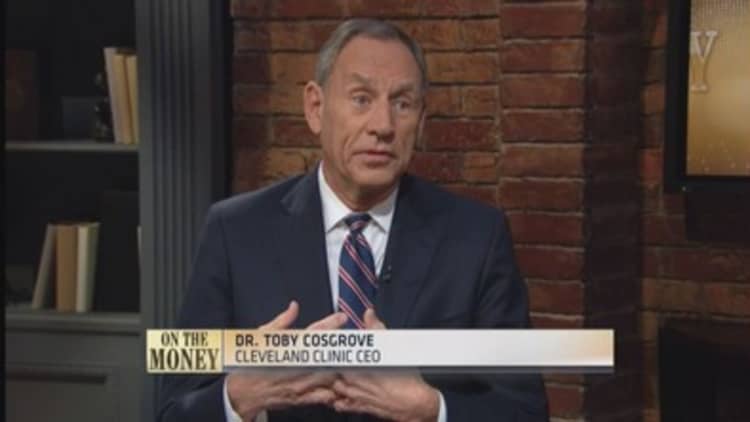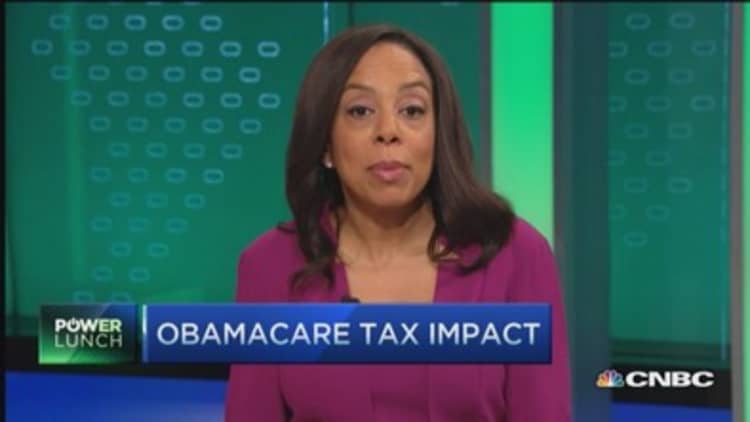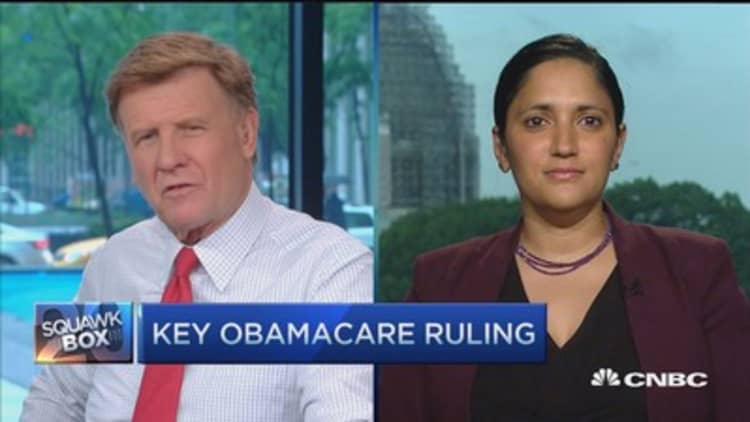


A major Texas health insurer is feeling "blue" from some steep losses and now wants sharply higher prices for Obamacare plans next year.
Blue Cross Blue Shield of Texas last year took up to a $400 million loss on its individual, Obamacare-compliant plans, according to filings disclosed earlier this week by the federal government. (Tweet this)
The loss stems from the difference between the $2.1 billion or so that BCBS took in from customers' premiums, and the $2.5 billion it paid out in health claims from those people.
BCBS cited that loss, which represents a 20 percent loss of premium on the insurers' Affordable Care Act-related plans, in requesting an average rate hike of 19.97 percent for individual plans next year, including those sold on the federal Obamacare exchange HealthCare.gov.
That increase would come on top of the 9.09 percent premium increase BCBS got approved for its plans in 2015.
Nearly 731,000 people are currently enrolled in those individual plans. If they stayed enrolled and if BCBS's proposed rates go into affect, individuals next year would see their retail premium prices change anywhere in the range of a cut of 3 percent to a hike of 20 percent, according to filings.
Lauren Perlstein, spokeswoman for the insurer's parent, Health Care Service Corp., said the rate filings reflect the insurer's "intention to offer an array of competitively priced products to existing and potential customers," and that it has "gained a tremendous amount of experience, insight and data," which was used to establish the rates.
Any discussion of average rate increases would be "misleading" because "rate changes individuals personally receive are impacted by a host of factors," Perlstein added.
Read MoreWill these big Obamacare rates happen?
She noted that eight out of every 10 BCBS customers receive federal subsidies to help offset, often greatly, the cost of their monthly premiums. For some customers of Obamacare exchange-sold plans, the subsidies mean that double-digit percentage hikes of retail premium prices will not translate into dramatically higher bills that customers will personally pay.
The spokeswoman also said BCBS had "no incentive to overprice our plans," because Obamacare rules mandate that insurers pay customers a rebate if they take in too much in premiums relative to claims, and because of state rate oversight.
BCBS's disclosure of its losses on Obamacare-compliant plans was unusual both for its large amount and for the fact that the insurer quantified the loss in dollar terms.
It also illustrates how some insurers priced their plans too low for Obamacare's first year, and are now seeking big percentage increases in prices to make up for the costs of providing benefits to their customers.
Those big proposed price hikes were disclosed Monday on HealthCare.gov, in a section called Rate Review, which included rate filings for much of the United States. But only proposed hikes of 10 percent or more were listed on the site.
Smaller increases and proposed reductions are not disclosed there, nor is the relative market share of the insurers who are seeking big price increases. The lack of complete information is making it difficult for analysts to get a clear picture of just how much Obamacare prices are likely to go up overall for 2016.
Many insurers other than BCBS "said little useful" in explaining why they want double-digit price hikes next year, noted Robert Laszewski, president of Health Policy and Strategy Associates.
Some insurers discussed, in percentage terms, what they were receiving in premiums compared to what they were paying out in benefits. Fewer still revealed actual dollar results.
"The Texas loss was huge in dollars" because of the amount of people BCBS covers, Laszewksi said.
But "in percentages, it's a fairly common loss. You will note that the huge dollar loss only drove a 20 percent increase," he said. "There are lots of 20 percent increases—and a lot more—indicating that there are lots of carriers in this boat, although few, if any, would have [731,000] covered lives in one market."
An example of that is UnitedHealthcare, which is seeking an average rate hike of 22.8 percent in Texas for individual plans sold outside of HealthCare.gov. The range of rate changes for customers would be between minus-2.3 percent to a nearly 43 percent increase.
Read MoreGOP's Obamacare 'fixes' have their own big risks
But the rates would affect just about 8,000 current customers.
UnitedHealthcare said that a review of its current premium rates indicates they "are not sufficient to cover the expected benefit and administrative costs," although it did not reveal the expected loss amount.
Scott and White Health Plan in Texas has asked for rates as much as 34.12 percent higher than this year. The insurer in its rate filing said that 5.3 percent of the price increase "is due to actual and expected unfavorable experience," suggesting claims exceeded premiums. A spokeswoman did not respond to requests for comment.
Time Insurance, a division of Assurant Health, is seeking proposed rates that would as much as 64.75 percent higher in Texas. But the company did not disclose the number of customers who might be affected.
Time Insurance's filings in Texas, and elsewhere, stand out in at least one other respect. While the proposed rate hikes are large, Time Insurance's filings say that they are for prices of new plans next year, which by definition have no current customers.
Asked about that oddity, Assurant spokeswoman Mary Hinderliter said, "We made changes to our plans and, therefore, they are considered new products. While we are filing a new product for 2016, there is a difference in the rate for our new 2016 product as compared to the rate for the product we offered in 2015. Assurant Health is meeting regulatory requirements in submitting 2016 filings as its parent company pursues a sale of the business."
"Rates are based on the projection of future claim costs, advancing technologies, increased medical costs and increased use of medical services and prior year rates relative to higher actual claims experience as well as new taxes and fees," Hinderliter said.
Assurant Inc. is exploring a sale of Assurant Health as it focuses its business on specialized housing and lifestyle insurance, according to the company. In April, Assurant revealed that Assurant Health expects to report a net operating loss for the first quarter of 2015 in the range of $80 million to $90 million. Half of that loss is attributable to a reduction in money the company expects to receive from an Obamacare program designed to reduce insurers' risk of covering customers, and the rest of the loss was chalked up to "elevate claims on 2015 ACA policies."
"Absent a sale of Assurant Health, the company will begin the process to exit the health insurance market and will not participate in the next ACA open enrollment beginning in November," the company said in April.
Texas wasn't the only state where an insurer revealed actual dollars losses as part of its argument for higher rates.
In Ohio, Medical Mutual is seeking average rate hikes of about 14.5 percent, although the range of price increases for its current 41,110 customers would be between 5.9 percent and 25.6 percent.
"The experience for [Medical Mutual] in 2014 was not favorable," the company said in the filing. It noted it had paid out more than $177 million in claims and received just $151 million in premium payments, which led to a loss of about $22 million "on individual ACA business alone."
Medical Mutual spokesman Ed Byers said the local media in Ohio has highlighted the double-digit proposed hikes. But he said the "hidden story here" is the relative size of the provider networks of insurers seeking double-digit increases compared to other insurers' increases.
Read MoreDon't mess with Medicaid expansion? Texas' lesson
"Broad coverage comes with a cost. That's a fact. That's Health Insurance 101," said Byers, noting that Medical Mutual's network includes the renowned Cleveland Clinic. "We did not narrow our networks, we did not skinny anything down."
Byers said that last year, some people who signed up for other plans were surprised to learn that their doctor or preferred hospitals were not covered in their plan's network.
"That's something that the consumer needs to consider," Byers said.
Caroline Pearson, senior vice president of the consulting company Avalere Health, said the data released earlier this week detailing double-digit price hike requests "doesn't matter much."
"We are crunching other numbers on how rates are changing for high enrollment plans in states where we have information," Pearson said. "Initial findings are that those plans are proposing very modest rate increases. These big increases only matter if plans have a lot of enrollees. Also, these are just proposed rates and could come down substantially."


